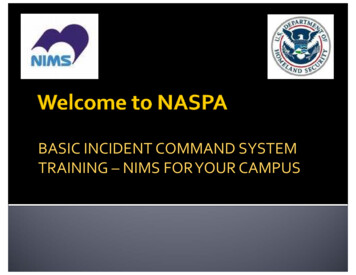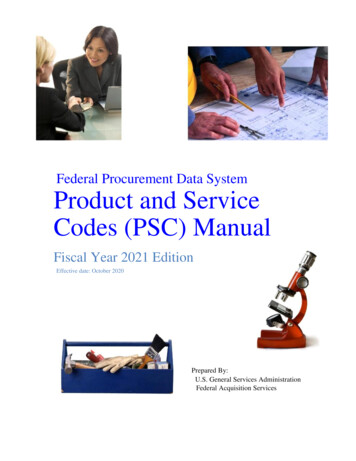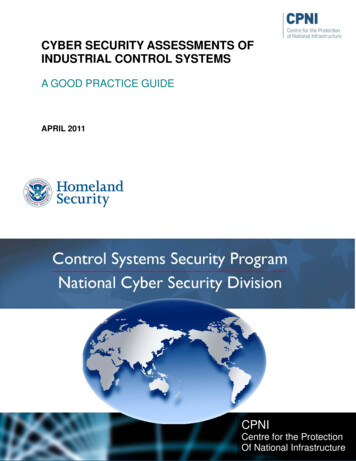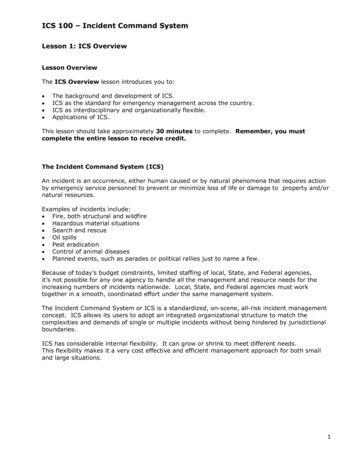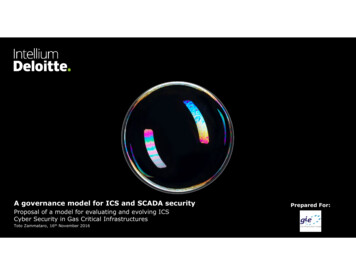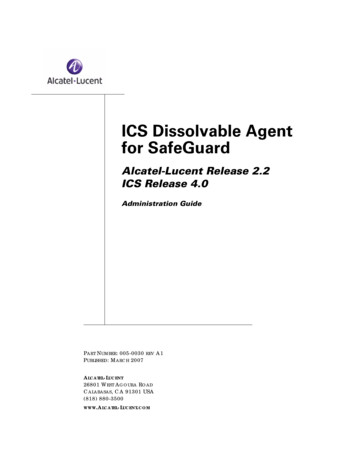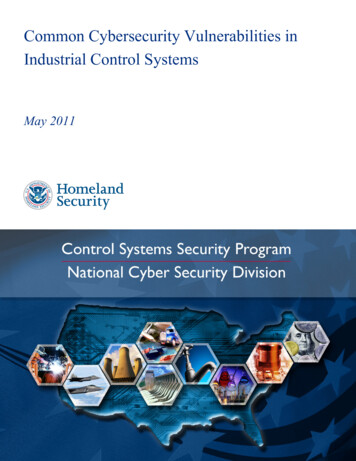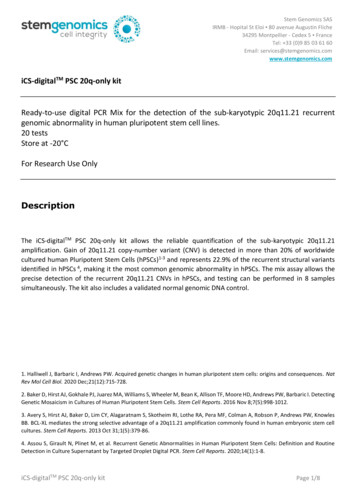
Transcription
Stem Genomics SASIRMB - Hopital St Eloi 80 avenue Augustin Fliche34295 Montpellier - Cedex 5 FranceTel: 33 (0)9 85 03 61 60Email: igitalTM PSC 20q-only kitReady-to-use digital PCR Mix for the detection of the sub-karyotypic 20q11.21 recurrentgenomic abnormality in human pluripotent stem cell lines.20 testsStore at -20 CFor Research Use OnlyDescriptionThe iCS-digitalTM PSC 20q-only kit allows the reliable quantification of the sub-karyotypic 20q11.21amplification. Gain of 20q11.21 copy-number variant (CNV) is detected in more than 20% of worldwidecultured human Pluripotent Stem Cells (hPSCs)1-3 and represents 22.9% of the recurrent structural variantsidentified in hPSCs 4, making it the most common genomic abnormality in hPSCs. The mix assay allows theprecise detection of the recurrent 20q11.21 CNVs in hPSCs, and testing can be performed in 8 samplessimultaneously. The kit also includes a validated normal genomic DNA control.1. Halliwell J, Barbaric I, Andrews PW. Acquired genetic changes in human pluripotent stem cells: origins and consequences. NatRev Mol Cell Biol. 2020 Dec;21(12):715-728.2. Baker D, Hirst AJ, Gokhale PJ, Juarez MA, Williams S, Wheeler M, Bean K, Allison TF, Moore HD, Andrews PW, Barbaric I. DetectingGenetic Mosaicism in Cultures of Human Pluripotent Stem Cells. Stem Cell Reports. 2016 Nov 8;7(5):998-1012.3. Avery S, Hirst AJ, Baker D, Lim CY, Alagaratnam S, Skotheim RI, Lothe RA, Pera MF, Colman A, Robson P, Andrews PW, KnowlesBB. BCL-XL mediates the strong selective advantage of a 20q11.21 amplification commonly found in human embryonic stem cellcultures. Stem Cell Reports. 2013 Oct 31;1(5):379-86.4. Assou S, Girault N, Plinet M, et al. Recurrent Genetic Abnormalities in Human Pluripotent Stem Cells: Definition and RoutineDetection in Culture Supernatant by Targeted Droplet Digital PCR. Stem Cell Reports. 2020;14(1):1-8.iCS-digitalTM PSC 20q-only kitPage 1/8
Kit ContentProductQuantity (volume)Mix20q20 testsControlDNA10 tests(30 µL - 50 ng/µL)ContentReference assay (HEX)Chr20q Target assay (FAM)Normal control DNA (male) with 2 copies of the 20q11.21 regionReagent StorageUpon reception, the kit must be stored at -20 C and protected from light.Repeated freezing and thawing must be avoided.Use PrecautionsFor all handling, laboratory coat and gloves must be worn.iCS-digitalTM PSC 20q-only kitPage 2/8
Required Reagents and EquipmentInstruments-Droplet Generator from Bio-Rad (recommended: QX200TM #186-4003)Droplet Reader from Bio-Rad (recommended: QX200TM #186-4003)96-well Thermal cyclerBenchtop centrifugeBenchtop vortexPlate sealer suitable for the Bio-Rad technology (recommended: PX1TM PCR Plate Sealer#181-4000)Materials-Pipettes and pipette tips (delivering volumes from 1 µL to 1000 µL)1.5 mL reaction tubesQX200 Bio-Rad ddPCRTM consumables (Droplet Generation Oil for Probes, DG8TMCartridges, DG8Cartridge Holder, DG8 Gaskets, ddPCRTM 96-well PCR Plates, and Heat Seal Pierceable Foil)Reagents-ddPCRTM Supermix for Probes (No dUTP) from Bio-Rad (#186033)HindIII-HF enzyme (e.g., New England Biolabs #R3104L)Nuclease-free wateriCS-digitalTM PSC 20q-only kitPage 3/8
Instructions for UseSample preparation-500 000 dissociated cells are sufficient for one test using the iCS-digitalTM PSC 20q-only kit.Genomic DNA should be extracted using an appropriate DNA extraction method. It is recommended touse the QIAamp DNA Blood Mini Kit (Qiagen, #51104) or the GenElute Mammalian Genomic DNAMiniprep Kits (Sigma-Aldrich, #G1N70-1KT).DNA purity and quantification-Quantify the double-stranded DNA (dsDNA) in each sample using a Qubit fluorometer. You will need atleast 3 µL of dsDNA at a concentration of 5 ng/µL for one test.Note: Using the QubitTM dsDNA HS Assay kit for DNA quantification is strongly encouraged because itgenerates highly accurate and precise results. Spectrophotometers tend to overestimate DNAconcentrations and this can potentially increase the risk of errors in the subsequent data analysis.-Dilute the DNA samples and control DNA to 5 ng/µL in molecular grade H20.Vortex the diluted DNA samples for 5 seconds, and centrifuge briefly.Digital PCR reagent preparation--If frozen, thaw the Mix assay and the ddPCRTM Supermix for Probes (No dUTP) at room temperature.Mix thoroughly by vortexing, and briefly centrifuge.Good homogenization of the kit reagents is critical to guarantee the quality of the final results.Therefore, we recommend users to vortex vigorously the Mix assay tube twice for 5-10 seconds,and to briefly centrifuge the tube between each vortexing steps.Calculate the number of samples to be tested, including the control DNA.Dilute the HindIII-HF restriction enzyme using the recommended dilution buffer to a concentration of2 U/µL.Prepare enough reaction mix for all samples. It is recommended to prepare at least 10% more mastermix than what required for the total number of reactions to be performed.The reaction volumes for one sample are detailed in Table 1.The reagents should be added in the following order: H20, iCS-digitalTM Mix, ddPCRTM Supermix forProbes (No dUTP), HindIII-HF and genomic DNA.iCS-digitalTM PSC 20q-only kitPage 4/8
Table 1. Reaction mix preparation for one sample-Order1Example for 1 sampleVolumeH2O5 µL2Mix 20q2 µL3ddPCRTMSupermix for Probes (No dUTP) 2X11 µL4HindIII-HF (2 U/µL)1 µL5Genomic DNA (5 ng/µL)3 µLMix thoroughly by vortexing the tubes and centrifuge briefly.Load 20 μL of each reaction mixture in a sample well of a DG8 Cartridge.Note: 8 samples (including the control DNA) can be run in the same cartridge, fill any unused wells withddPCR Buffer Control for Probes (Bio-Rad #1863052).-Add 70 µL of Droplet Generation Oil for Probes in the bottom wells of the cartridge (oil wells).Attach a gasket across the top of the DG8 cartridge and place it in the QX200 Droplet Generator.After droplet generation, remove the gasket and transfer the droplets (40 µL) from the upper wells ofthe DG8 cartridge into a single column of a 96-well PCR plate by pipetting gently.Seal the PCR plate using heat seal pierceable foil and a thermal plate sealer.PCR program-Perform thermal cycling as detailed in Table 2.Table 2. Thermal cycling programStageEnzyme activationDenaturationAnnealingEnzyme deactivationHold-Number of cycles1454511Duration10 min30 sec1 min10 minInfiniteTemperature95 C95 C60 C98 C12 CRamp rate2.5 C/secIf required, set the reaction volume to 40 µL.The recommended lid temperature is 105 C.Note: Leave the PCR plate in the cycler for at least 4 hours, and if possible, overnight. This step increasessignificantly the number of droplets.iCS-digitalTM PSC 20q-only kitPage 5/8
QuantaSoftTM Experiment Setup-Place the PCR plate in the plate holder of the QX200 Droplet Reader.Open the QuantaSoftTM software from the computer connected to the droplet reader and configure anew plate template in the plate editor (Figure 1), as follows: For all wells:o Experiment type - CNV2o Supermix type - ddPCR Supermix for Probes (No dUTP)o Target 1 Type: Ch1 Unknown Label: 20qo Target 2 Type: Ch2 Reference Label: Ref For each well:o Sample name - to be specified by the userFigure 1. Example of plate configuration-Click Run and select the FAM/HEX dye set.iCS-digitalTM PSC 20q-only kitPage 6/8
Analysis of results:QuantaSoftTM cluster analysisTo analyse the PCR data, use the QuantaSoft Analysis Pro software (version 1.0.596):-In the “Plate Editor” tab (Figure 2), select all the wells to be analysed.In Assay Information, select from the dropdown list “Simplex/Duplex”.Refer to Figure 1 below for filling in target name, type and signal.Press “Apply” to save the changes.Figure 2. Example of QuantaSoftTM Analysis Pro Plate Editor tab parameters-In the “2D Amplitude” tab (Figure 3), adjust the threshold using the Graph Tools, either manually(Threshold Cluster Mode) or automatically (Threshold Line Mode), to assign each cluster to theappropriate target.iCS-digitalTM PSC 20q-only kitPage 7/8
Figure 3. QuantaSoftTM Analysis 2D Amplitude results. A. Example of 20q genetic assay target combinationclusters. B. Example of 2D plot after threshold assignment.--Refer to the “Concentration” and “Copy Number” tabs for results analysis.Data can be exported for subsequent analyses through the Well Data table.iCS-digitalTM PSC 20q-only kitPage 8/8
- Quantify the double-stranded DNA (dsDNA) in each sample using a Qubit fluorometer. You will need at least 3 µL of dsDNA at a concentration of 5 ng/µL for one test. Note: Using the QubitTM dsDNA HS Assay kit for DNA quantification is strongly encouraged because it generates highly accurate and precise results.
